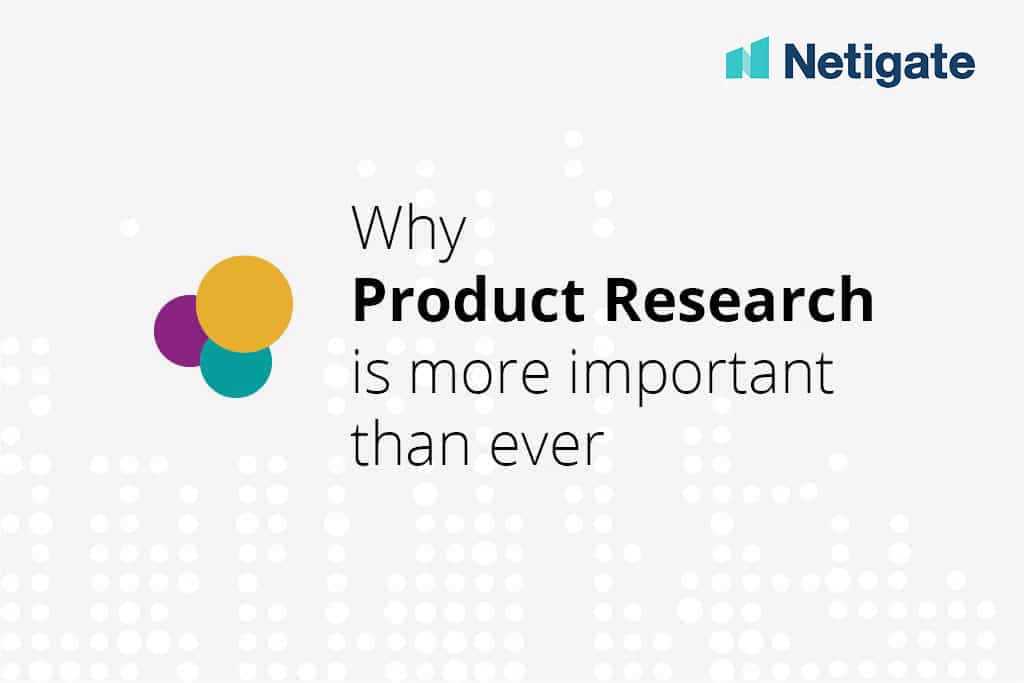Table of Contents
The ultimate guide to product research in the age of customer experience
Product research – maybe you have been conducting it for years or it just seems naturally straightforward to you? When you think you already know everything there is to know about this important branch of market research – think again!
In many companies, product research has not changed much since the last century with the exception of more traditional survey techniques like telephone and face-to-face interviews being complemented by online surveys in the move towards digitalisation. Do not stop there and start taking into account new customer cultures too!
In this article, we at Netigate share our experience and advice on how you can take your company’s product research into the 21st century and catch up with the transformations of the age of customer experience. In our article “All you need to know about Customer Experience (CX)”, we detailed how value today is no longer decided by price and availability alone, but through created experiences that set one business apart from the others. This also has far-reaching consequences for your product research.
The evolution of product research
Born as a concept in 1910 in the United States, as part of wider market research, product research is based on the idea that collecting and analysing qualitative and quantitative data from potential and existing customers help companies make informed decisions on new products, product-improvements or product marketing strategies and thus create more successful choices for the market.
Traditional research techniques such as face-to-face or telephone interviews, paper questionnaires, and discussion groups were complemented and product research revolutionised in the 1990s with the introduction of panel surveys, the targeted questioning of a curated group of people that match certain criteria (age, gender, profession, interest, location, socio-economic status etc.). The digitalisation of surveys then made it possible to reach out to anyone you want to reach.
The evolution of product research naturally did not happen in a bubble but was closely linked to other ideas in market research and marketing. Such as, importantly, the idea that your brand and your products should be tailored towards a target customer group that is matched by your product and company experience.
Areas of product research
The following are areas in which you can use product research to further your product’s success. Keep in mind to make your survey focused and do not try to answer too many questions and tackle more than one area at once.
- Product improvements: You have a product you would like to change slightly? Make sure that your customers love the new features and that the product still aligns with your brand’s image.
- New product: Product research can be a real driver for innovation. If you thought of something new, test if there is a market for your product idea. Then learn what potential customers want and need, that you can offer them. You find more information on this further down.
- Your target group: Learn more about your current customers, their interests and values or explore what other potential customer groups are out there.
- Your competitors: Who are the companies and brands that offer similar products to you and what do customers like about them/don’t like about them? What differentiates your product experience from theirs?
- Marketing strategies: The above can be a good starting point to gain valuable insights for your marketing strategy. What is so unique about your product? Where exactly in the product lies the experience and how can you highlight these aspects to appeal to your audience?
Checklist for general product research
1) Research Goal.
Before you start thinking about survey questions and panel criteria, make sure you have a clear goal of what you want to achieve with the product research. Taking into consideration that you are trying to create an experience for your customers and not just increase satisfaction rates. Do not aim at simply finding out what customers like and do not like but try to uncover how this links to their values, their image of your company, and the experience you are wanting to create for them.
2) Identifying desired respondents/Creating a panel.
Product research is all about who you ask to take part in the survey. Other than asking your own customers it is insightful to conduct a panel survey, in which participants of your chosen demographic criteria (age, gender, location, profession, interests etc) are selected and contacted to respond to your survey. Again, remember that your product in most cases is not meant to appeal to every single person, but is designed to match a certain customer group – turn to them and closely related groups with your product research.
3) Choosing Questions and designing layout.
The questions and the design of your survey should match your company spirit and image. Concentrate on who you are and want to be. If you, for instance, focus on environment-friendly and ethical products prioritise these aspects in the order of the questions and give the survey design a matching personal touch that expresses this brand experience.
4) Integrating Results into market research and marketing strategies.
Make the most of the insights gained in your product research by combining them with other data from customer feedback surveys to optimise your products and brand image. Creating a coherent and gripping customer experience is all about unifying all aspects of your business and its offer.
5 steps to implement new product research
Research in collaboration with your target group is essential to all the following steps in the process of developing and introducing a new product or service to the market.
- Determine customers’ wants and needs. In this crucial step, read feedback and opinions on social media platforms and personal blogs to find out what your target group wants and cares about in a product or service. Have a second look at the customer feedback you already collected to see what the most common complaints and suggestions were. If possible, consult internal or external experts of the sector.
- Develop and concretise ideas. Get your team together and develop product ideas in e.g. creative workshops or brainstorming sessions. You should involve an active online community and ideally your target group, for example in a panel survey. Ask what they are missing in your brand experience. Often they have already thought about what other product they would like.
- Choose and optimise an idea. Use quantitative and qualitative idea-screening to select an idea with which you want to go forward. With online surveys showing respondents different product options you can collect a large amount of data on the different ideas. In combination with qualitative and more in-depth information from interviews and focus groups. Use the same process to optimise the chosen product idea.
- Test your prototype. Based on the information you collected in the previous steps, you can now develop a product prototype. As well as use market research to test its validity and gauge its future success. Does a select group of your customers e.g. your panel, like the product? Do they consider it to be in line with the experience they expect from your business?
- Develop a marketing and communication strategy. Use the information you have gained in previous steps. What are your brand’s and product’s strength and points of uniqueness? How do they create an experience that connects with the values and expectations of the customer? Integrate the findings with those gained in brand, price, and competitors research.
Find out more about product research and panel research on our website.
-
Sophie Hedestad
-
Sophie Hedestad
- 5 min read
- .






